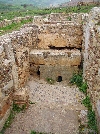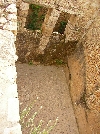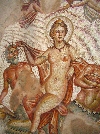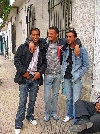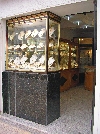
Tunisia Odyssey: Historic North
Bicycle Africa / Ibike Tours
Dispatch 7 - Jendouba
Not part of the scheduled program, last night we were awakened by an extremely loud and long, rolling claps of thunder. One person thought a wooden wheeled cart was being driven over a cobblestone street just outside a second story window and another thought it was an earthquake, but nothing was moving. It was the loudest and longest continuous rumble most of us had ever heard. It was followed ten seconds later by another one, not quite as extended. Both were accompanied by bright streaks of lightening and then an immediate deluge which lasted for all of three minutes before easing to a light rain. Sometime around four the silence and sleep that had returned was broken by the plaintiff hoot of an owl. It would give one distinct hoot followed by a shorter hoot with a tremolo in it and repeated this every ten seconds. No owl in European bird book meets this description.
By the time we had our bikes loaded, the road was drying in places and had no standing water. Though it was not as cold as we had expected based on the temperature last night, it was still cool enough for a jacket and some of us added extra layers beyond that. Weather has featured prominently in a couple other Ibike visits to Ain Draham. Though the locals have said each time that it was a freak occurrence, twice, out of maybe six-eighteen hour visits in mid-April (scattered over a decade), we have had measurable snow during our visits in Ain Draham.
 The
route south goes down for a few kilometers to a valley, and past a large
gymnasium and sports field area, after which we hit another ascent that sent
us into our low gears for another few kilometers.
The
route south goes down for a few kilometers to a valley, and past a large
gymnasium and sports field area, after which we hit another ascent that sent
us into our low gears for another few kilometers.
 Again,
this was mostly cork oak forest. This time with a few trees with naked
red trunks indicating their outer layers have been recently removed. Then we
enjoyed the downhill we had worked all yesterday for. Luckily the descent
Again,
this was mostly cork oak forest. This time with a few trees with naked
red trunks indicating their outer layers have been recently removed. Then we
enjoyed the downhill we had worked all yesterday for. Luckily the descent
 was
not as steep as yesterday's climb and the road was good so we generally
didn't have to ride our brakes. For the first half we were barreling out of
the wooded mountains, but then we entered
was
not as steep as yesterday's climb and the road was good so we generally
didn't have to ride our brakes. For the first half we were barreling out of
the wooded mountains, but then we entered
 rolling
farm land with the sparkling green fields and myriad of wildflowers we've
seen in this northern section. We passed through a couple rural villages
with children headed to school and adults going about their morning
routines. A gaggle of foreign cyclists with fully loaded bikes racing
through town must have been a real sight. The biggest of
the towns is Feriana, which means "Cork Tree." Tree
acted as oracle for Khroumir people. This particular oracle has since been cut down.
The town looks like it is growing by leaps and bound. About half the house
and a large high school look like they had been built in the last couple of
years.
rolling
farm land with the sparkling green fields and myriad of wildflowers we've
seen in this northern section. We passed through a couple rural villages
with children headed to school and adults going about their morning
routines. A gaggle of foreign cyclists with fully loaded bikes racing
through town must have been a real sight. The biggest of
the towns is Feriana, which means "Cork Tree." Tree
acted as oracle for Khroumir people. This particular oracle has since been cut down.
The town looks like it is growing by leaps and bound. About half the house
and a large high school look like they had been built in the last couple of
years.




 The
last portion of the ride was rolling hills
through this bucolic scene. Under the overcast skies, the eye seemed
to pick up the beauty better than camera but even so on several occasions
people turned around and pedaled back to take a photo of wildflowers and
scenery.
The
last portion of the ride was rolling hills
through this bucolic scene. Under the overcast skies, the eye seemed
to pick up the beauty better than camera but even so on several occasions
people turned around and pedaled back to take a photo of wildflowers and
scenery.
Before entering Jendouba, our stop for the night, we
toured another site of ancient Roman ruins called Bulla Regia. This splendid
site is the only known example of a subterranean classical city. Upon
pulling in we were surprised to see the
 Tunisian
English language tour guide, Amel, who had borrowed a copy of the Lonely
Planet Guide in Tebersouk to prepare for a tour she was to give her Japanese
clients on the next day. She was to be our guide for Bulla Regia, her
favorite site.
Tunisian
English language tour guide, Amel, who had borrowed a copy of the Lonely
Planet Guide in Tebersouk to prepare for a tour she was to give her Japanese
clients on the next day. She was to be our guide for Bulla Regia, her
favorite site.
 The
archeological record shows that it had been inhabited by Berber in the 5th C BC.
In the 2nd C BC, it was the throne for the Numidian King Micipsa. By the
end of the century the residence of Bulla Regia were more directly under Roman rule
and felt mistreated. From 118-105 BC, Numidian King
Jugurtha rebels against Romans. His army was defeated 25km from Bulla Regia.
This was followed by a Romanized
Berber period. It lied on a main road from Hippo Diarrytus (Bizerte)
to Vaga (El Kef), with other well used connection to Chimtou and Tabarka, and
west to present day Algeria. At its height the population is estimated to have reached 5000; 30,000 to 50,000 counting women and
slaves. It was the Romans who definitely put their distinctive stamp on this city
which was at its peak in the second and third centuries.
The
archeological record shows that it had been inhabited by Berber in the 5th C BC.
In the 2nd C BC, it was the throne for the Numidian King Micipsa. By the
end of the century the residence of Bulla Regia were more directly under Roman rule
and felt mistreated. From 118-105 BC, Numidian King
Jugurtha rebels against Romans. His army was defeated 25km from Bulla Regia.
This was followed by a Romanized
Berber period. It lied on a main road from Hippo Diarrytus (Bizerte)
to Vaga (El Kef), with other well used connection to Chimtou and Tabarka, and
west to present day Algeria. At its height the population is estimated to have reached 5000; 30,000 to 50,000 counting women and
slaves. It was the Romans who definitely put their distinctive stamp on this city
which was at its peak in the second and third centuries.
Drawn to the area
because of its prime agricultural land, the Romans took a lesson from the
troglodytes of southern Tunisia on how to escape the
 oppressive summer heat by
oppressive summer heat by
 moving underground
when the weather got hot. Typical of Roman and other towns, this town
had a district of public buildings and facilities and a section of private
buildings. Though the site has a forum (political, judicial and religious
center of community), Temple of Apollo (statues in Bardo, god of sun, art, music, poetry, beauty, manly
youth and medicine), Temple of Jupiter (Zeus), Juno (Hera, Zeus' jealous
wife and protector of married women) and Minerva (Zeus' immaculate daughter,
goddess of purity, wisdom, warfare, cities and handicraft), basilica, market
with two fountains, trifollium actors baths, Theater (161-180 AD) (statue of
Emperor - change only head, dedicated to Ceres, goddess of grain and
summertime), Temple of Iris (E) (Fertility, sister of Isis), Monumental
Enclosure (perhaps Numidian palace), library, markets, baths (Bath of Julia Memmia
(3rd C), a wealthy
patron; it contained a cloakroom with 6 lockers, frigidarium with two pools, tepidarium, caldarium heated through pipes,
and gymnasium with six lockers) (3rd C), and many other familiar buildings, it
is really the villas that have been excavated and only moderately restored that
are the standouts. Surprisingly, much of the structure is original.
moving underground
when the weather got hot. Typical of Roman and other towns, this town
had a district of public buildings and facilities and a section of private
buildings. Though the site has a forum (political, judicial and religious
center of community), Temple of Apollo (statues in Bardo, god of sun, art, music, poetry, beauty, manly
youth and medicine), Temple of Jupiter (Zeus), Juno (Hera, Zeus' jealous
wife and protector of married women) and Minerva (Zeus' immaculate daughter,
goddess of purity, wisdom, warfare, cities and handicraft), basilica, market
with two fountains, trifollium actors baths, Theater (161-180 AD) (statue of
Emperor - change only head, dedicated to Ceres, goddess of grain and
summertime), Temple of Iris (E) (Fertility, sister of Isis), Monumental
Enclosure (perhaps Numidian palace), library, markets, baths (Bath of Julia Memmia
(3rd C), a wealthy
patron; it contained a cloakroom with 6 lockers, frigidarium with two pools, tepidarium, caldarium heated through pipes,
and gymnasium with six lockers) (3rd C), and many other familiar buildings, it
is really the villas that have been excavated and only moderately restored that
are the standouts. Surprisingly, much of the structure is original.
 The villas
were two story structures with
the "first story" completely beneath the ground and the "second story" at
ground level. The few villas that have been excavated are generally
named for a prominent feature in a mosaic found in at the location; House of the
Treasure (7th C coins removed; trifollium - symbol of goodness, peace and contentment), Byzantine
fort, Byzantine Christian Basilica (baptismal), House of the Peacock, House
of the Hunter (heating/cooling pipes, octangle windows, plaster/painted
walls, bath and toilet on ground level and near road, Roman mosaic removed),
New House of the Hunter (heating/cooling pipes, Roman mosaic removed), New
House of the Hunter (hunting mosaic), House of Venus (reconstructed eyes)
(138-161), House of Fishing
(117-138) (oldest villa, square columns with Egyptian capitols and cobra,
Byzantine fountain, no ventilation pipes, high humidity, no circulation,
little light), Amel said that during the
winter, the families lived at ground level, but when
The villas
were two story structures with
the "first story" completely beneath the ground and the "second story" at
ground level. The few villas that have been excavated are generally
named for a prominent feature in a mosaic found in at the location; House of the
Treasure (7th C coins removed; trifollium - symbol of goodness, peace and contentment), Byzantine
fort, Byzantine Christian Basilica (baptismal), House of the Peacock, House
of the Hunter (heating/cooling pipes, octangle windows, plaster/painted
walls, bath and toilet on ground level and near road, Roman mosaic removed),
New House of the Hunter (heating/cooling pipes, Roman mosaic removed), New
House of the Hunter (hunting mosaic), House of Venus (reconstructed eyes)
(138-161), House of Fishing
(117-138) (oldest villa, square columns with Egyptian capitols and cobra,
Byzantine fountain, no ventilation pipes, high humidity, no circulation,
little light), Amel said that during the
winter, the families lived at ground level, but when
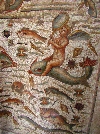 summer came most of
their time was spent in the subterranean villa. Though the concept from the troglodytes is
here, the execution is vastly different. The underground spaces are enormous
with twenty foot ceilings, once marbled walls, huge floor mosaics, and large
columns to hold up the roof. Although many of the mosaics have been moved to
the Bardo (along with statues, frescos, and other valuable art works), some
have been left in situ. Two in particular are worth
summer came most of
their time was spent in the subterranean villa. Though the concept from the troglodytes is
here, the execution is vastly different. The underground spaces are enormous
with twenty foot ceilings, once marbled walls, huge floor mosaics, and large
columns to hold up the roof. Although many of the mosaics have been moved to
the Bardo (along with statues, frescos, and other valuable art works), some
have been left in situ. Two in particular are worth
 noting. One is of
Venus attended by her minions and the other is a traditional
noting. One is of
Venus attended by her minions and the other is a traditional
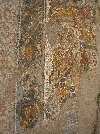 hunt scene with
many graphic animals including a lion hunt. It is hard to imagine how these
delicate pieces of colored stone have withstood two centuries intact with
colors
hunt scene with
many graphic animals including a lion hunt. It is hard to imagine how these
delicate pieces of colored stone have withstood two centuries intact with
colors
 so vibrant, but then Amel told us that a series of earthquakes
and erosion had
destroyed much of the upper level which had then filled the lower level with
debris, cutting it off from light and air and thus preserving it to some extent from the ravages of time.
so vibrant, but then Amel told us that a series of earthquakes
and erosion had
destroyed much of the upper level which had then filled the lower level with
debris, cutting it off from light and air and thus preserving it to some extent from the ravages of time.
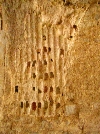
 The inventiveness of the Romans was
everywhere evident. The area evidently gets plenty of water and the site has
many cisterns, aqueducts and catch basins, as well as ducts to take away waste water.
Some of the underground rooms had vaulted
The inventiveness of the Romans was
everywhere evident. The area evidently gets plenty of water and the site has
many cisterns, aqueducts and catch basins, as well as ducts to take away waste water.
Some of the underground rooms had vaulted
 ceiling
and clay pipes built into the walls to reduce the humidity and promote
ventilation to the surface, as well as atria and high windows to let in light
and air. It is also the only site in Africa with a distinctive wall
construction pattern called opus reticulum (left).
ceiling
and clay pipes built into the walls to reduce the humidity and promote
ventilation to the surface, as well as atria and high windows to let in light
and air. It is also the only site in Africa with a distinctive wall
construction pattern called opus reticulum (left).
 The Byzantines occupied the city for awhile
in the 6th C AD,
adding a fort, Christian church, modern villas and replacing some of the mosaics with their own
more coarse patterns.
None of this is as impressive as the legacy of the Romans.
The Byzantines occupied the city for awhile
in the 6th C AD,
adding a fort, Christian church, modern villas and replacing some of the mosaics with their own
more coarse patterns.
None of this is as impressive as the legacy of the Romans.
 Then the site was abandoned for good in the seventh
or twelfth century (depending upon your source) and was not rediscovered until
1850, surveyed in 1881, excavated 1919-1990. When asked why UNESCO was not involved, Amel said the current
Tunisian director was the problem. Only a small percentage of the
site had been excavated, a fact easily verified by a visual survey of the site which
was more open field than excavations. She is hopeful that archeological work will
resume
again here some day.
Then the site was abandoned for good in the seventh
or twelfth century (depending upon your source) and was not rediscovered until
1850, surveyed in 1881, excavated 1919-1990. When asked why UNESCO was not involved, Amel said the current
Tunisian director was the problem. Only a small percentage of the
site had been excavated, a fact easily verified by a visual survey of the site which
was more open field than excavations. She is hopeful that archeological work will
resume
again here some day.
Although we've been to the Bardo and seen the wonders there before visiting sites like Dougga and Bulla Regia from which they come, it is hard to put the two pieces together in your mind. It would be nice if they had displays at appropriate locations at the archeological sites with pictures of the mosaic now at the Bardo, in situ, before it has been removed. Even so, this site has perhaps the most complete picture of the Roman architecture than any of the other sites we've visited so far this trip.

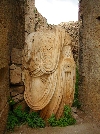 The theatre offered an interesting antidote: At the entrance to a
tunnel there is the torso of the empire. They were made so the heads
could be changed. Evidently, there was little in
The theatre offered an interesting antidote: At the entrance to a
tunnel there is the torso of the empire. They were made so the heads
could be changed. Evidently, there was little in
 the
way of changes in fashion trends, but they needed an economical way to
change to look of the statue as emperors came and went. With this
system, when the emperor was changed only a new head need to be carved, not
the whole statue.
the
way of changes in fashion trends, but they needed an economical way to
change to look of the statue as emperors came and went. With this
system, when the emperor was changed only a new head need to be carved, not
the whole statue.
Before we left the site a group of bee eaters, always a fun bird to see, flew through displaying their aerial skills. Even in the diffused light, their bright yellow-orange flashed.

 For our short ride back to town,
we took a short detour across a farm and down a rutted dirt lane with an
explosion of wildflowers and thistles on either side. The path all but
For our short ride back to town,
we took a short detour across a farm and down a rutted dirt lane with an
explosion of wildflowers and thistles on either side. The path all but disappeared after a kilometer or so, and we were brushing through greenery
to our shoulders -- the adjacent field was left fallow and the vegetation
much more copious that when it is a controlled wheat field. After pass
through a small suburb we joined a stream of non-motorized traffic to cross
a bridge, which looks like it might have started life as a railroad bridge.
disappeared after a kilometer or so, and we were brushing through greenery
to our shoulders -- the adjacent field was left fallow and the vegetation
much more copious that when it is a controlled wheat field. After pass
through a small suburb we joined a stream of non-motorized traffic to cross
a bridge, which looks like it might have started life as a railroad bridge.

 Jendouba
is a working class town
with nothing extraordinary of note, save the large number of stork nests atop every
possible nesting site. The town's minaret even has one prominently located,
as does the police station.
All of the nests appear to be occupied and all seem to have young storklets
getting fed by their parents. Storks are very definitely a going concern in
this part of Tunisia. But even without extraordinary, Jendouba has a
flow of life and a full range of activities:
Jendouba
is a working class town
with nothing extraordinary of note, save the large number of stork nests atop every
possible nesting site. The town's minaret even has one prominently located,
as does the police station.
All of the nests appear to be occupied and all seem to have young storklets
getting fed by their parents. Storks are very definitely a going concern in
this part of Tunisia. But even without extraordinary, Jendouba has a
flow of life and a full range of activities:
From left to right: The train arrive and departs sending people surging through the station. The central square. Bicyclists going through the market. A fruit stand.
From left to right: Vegetable stand. Butcher shop. Shopping street. Men playing chess.
From left to right: The young guys who wanted their picture taken because I had taken a picture of the old men playing chess. A chicken roti restaurant. A jewelry shop. A sidewalk cafe. And, a clothing boutique.
Our supper was at the hotel. Ojja , roasted veal and grilled chicken
were popular. The ojja was excellent. The roasted veal was reviewed by
the Ibike critics as being very tender and tasty, whereas the chicken was
overcooked. We had seen what our guide called Berber bread at one of
the tables of locals as we walked in (we were the only foreigners.)
Our effort to
ask our somewhat surly waiter if we could have this instead of the normal
French bread and were rebuffed in no uncertain terms. Ten minutes later one of
the gentlemen from an adjacent table placed five of the malleable, flat
"loaves", rolled together in a paper, a on our table.
 He had overheard our
conversation and had left the hotel to go out on the street and purchase the
bread for us. What a kind and welcoming gesture! The bread is, for all
intents and purposes, the same as the naan you can order from Indian
restaurants. It is shaped and looks a bit like a large pancake, but tears
with a consistency more like bread. It was warm and tasty and really hit the
spot.
He had overheard our
conversation and had left the hotel to go out on the street and purchase the
bread for us. What a kind and welcoming gesture! The bread is, for all
intents and purposes, the same as the naan you can order from Indian
restaurants. It is shaped and looks a bit like a large pancake, but tears
with a consistency more like bread. It was warm and tasty and really hit the
spot.
In the area, but off on side roads are: Thuburnid (1st C BC), rounded by Romans after defeat of Jugurtha. And Chemtou (2nd BC) a Numidian marble quarry with the only yellow marble in the Roman Empire. [The only green marble is from Makthar.] Marble was first shipped to Rome in 78 BC. Chemtou was at its height in the 2nd-3rd C Period of main site ruins: aqueduct, bathes, theater, forum, bridge, flour mill.
![]()
![]()
Unique Programs To Special Places For Memories Of A Lifetime!
![]()
![]() Please
write if you have questions, suggestions and comments about our program or want to be
added to Bicycle Africa's mailing list. (Also let us know how you found this site.)
Please
write if you have questions, suggestions and comments about our program or want to be
added to Bicycle Africa's mailing list. (Also let us know how you found this site.)




